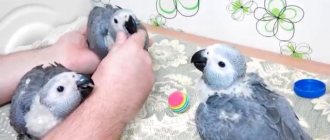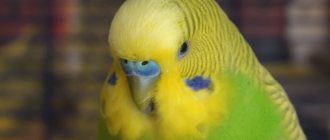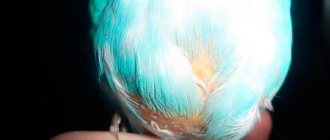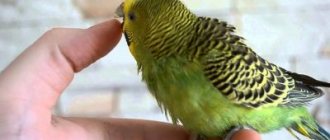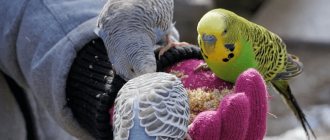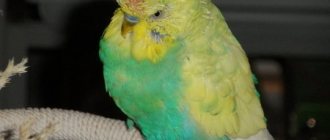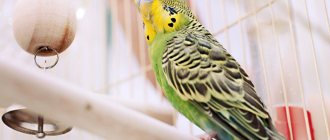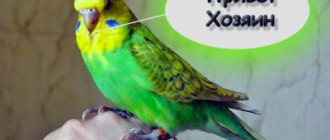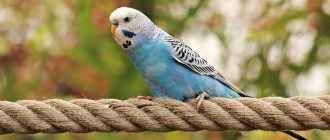It's a very exciting moment when your favorite little parrot says his first word, especially if it's your name. Some parrots are able to remember a prayer or poem. But do you wonder when you hear a parrot recite poetry, does he understand what he is saying?
Maybe he's just mindlessly imitating words? Or are parrots smarter and smarter than we think about them? According to Irene Pepperberg's research, parrots are capable of more than just imitation.
Unlike other animals, parrots' vocal apparatus allows them to easily imitate human speech. Parrots, according to Pepperberg, learn to communicate in a flock with each other by imitating the calls of adult birds.
Interesting fact: parrots in the wild learn to communicate with each other by imitating the calls of adult birds.
Brain
The ability to imitate is complemented by an altered brain structure with areas dedicated to imitating sounds. This is why parrots are so good at this compared to other animals. Researchers believe that this brain structuring allows them, among other things, to perceive and reproduce music. As we know, parrots often hum familiar tunes or even dance to the rhythm.
But parrots can speak not only because of their special structure, but also because of their incredible sociality. The worst fate for this bird is to sit alone in a cage. They need a partner. Or a person who will devote all his free time to his pet.
Why parrots imitate speech and imitate other sounds
Parrots are social creatures. In the wild they live in packs. They need language to communicate. Upon hatching, the chicks quickly learn to communicate with adult birds. When placed in an unfamiliar environment, parrots imitate the sounds they hear around them.
In other words, living in human society, the parrot begins to consider people members of its flock, build bridges and master a common language. If such a bird were to fall into a herd of cows, it would learn to moo. If I were among dogs, I would start barking.
Improper feeding
The budgerigar is an active bird, constantly on the move. A healthy parrot jumps from branch to branch, walks along the bottom and pecks grains, tears paper, but it will not sit on the floor of the cage. Then it is not entirely clear why the parrot suddenly began to spend a lot of time below. Probably his paws get tired of clinging to the perch, and it’s more comfortable to sit on the pallet. The reason for this condition is errors in nutrition: excess fatty foods or lack of nutrients.
Obesity in a parrot
You need to feed your pet not on demand, but on time, observing the portion size. If you do not adhere to dietary standards, the parrot will get used to overeating, due to which it will gain excess weight. A heavy body is a load on the legs and wings. An obese bird has difficulty moving and simply feels discomfort.
Monotonous food
On a note! It should also be noted that starvation is one of the reasons for bird weakness. The food may be of poor quality, and the parrot will not get enough of it. In some cases, exhaustion is caused by switching to another food that the pet does not like.
Optimal age for training
Undoubtedly, the best option would be to take a month-old parrot, since young chicks are easier to teach to speak than an older bird. Moreover, the sooner you begin to teach him to speak, the faster your feathered friend will expand his vocabulary. And by the age of two or three, with regular training, you will already be able to exchange a few words with your pet.
It is impossible to answer unequivocally that all speaking individuals learn in the same way. Since some species begin to speak faster, and have in their vocabulary not only words, but also entire phrases and sentences. Others are only capable of reproducing various sounds or melodies.
Now let’s try to figure out which parrot is easiest to teach to speak.
Let's start with the wavy , it is better to take a small one from 30 to 32 days from birth. It is advisable to choose a male individual. When learning to speak, patience is important, since for a good and quick result, you will have to diligently and clearly pronounce the phrases you want to teach your pet for 3-3.5 months.
It is important that the pet is not afraid of you and easily allows you to approach the cage, then learning spoken language will take place in a more comfortable environment for him.
Cockatiels are quicker to learn to speak than their wavy counterparts. The period ranges from 2 to 3 weeks, subject to daily repetition of words and phrases. If you don’t have time to regularly train your pet, you can record the words you are learning with the bird at approximately 15-20 second intervals, so your pet won’t confuse words and phrases. But this method can only be used as a last resort, since communication with a person cannot be replaced by equipment.
The Gray is considered the easiest to train chatterbox among parrots. Just like other species, it is better to buy talkers when they are small and teach them to talk from infancy.
The duration of the lesson should not be more than 5-10 minutes, 2-3 times a day, daily. Thus, some individuals are able to remember and reproduce words already in the first lesson.
Thus, the last of the three types of parrots is considered the most intelligent, talkative and quickly trainable.
Individual species learn at different rates, so when your parrot starts talking depends on its characteristics and species. Some need 3 to 4 months, others a few weeks, and others are ready to exchange a few words on the first day.
It is also impossible to say unambiguously at what age parrots begin to speak, since this will depend on the pet itself, on its species, and on the degree of skill of the breeder. For example, budgerigars, if properly trained, begin to chat from 5 to 10 months of age, Corellas from 4 to 10 months, and Grays from 3 to 9 months of age.
I would like to note that some individuals, despite all their efforts and age, cannot learn to speak.
How to teach a parrot to speak in 5 minutes
Parrots are of course very talented and some of them can really support their owner in a conversation. But despite this, it is simply impossible to teach a feathered friend to speak in five minutes. In any case, the learning process will take a lot of time and patience, be it even the most talkative parrots, such as Macaws, Grays, and Cockatoos.
To teach your pet to speak as quickly as possible, it is necessary to conduct classes daily, three times a day for 10-20 minutes. Only then, after about 3-4 weeks, will the feathered friend perhaps say a word or phrase.
Therefore, no matter how hard you try to quickly teach a parrot to talk, it will not work; it will take quite a lot of time.
What is the purpose of mimicry?
The songbird sings to attract females.
In the 1930s, scientists noticed that male songbirds were better at mimicking than females. This led them to believe that vocal mimicry evolved as a result of vocal training practiced by male birds to attract females for mating. Moreover, male songbirds imitate primarily during the mating stage, suggesting that vocal mimicry evolved as a byproduct of song learning.
Some songbirds have also been observed to imitate sounds to avoid predators.
Treatment
Every owner should be able to provide first aid to a feathered pet. If you have a cold, it is enough to warm the parrot (turn on an infrared lamp near the cage) and drink it with chamomile infusion.
Poisoning is of particular concern: small parrots have a very fast metabolism. Toxins that enter the body instantly penetrate all systems. A ruffled parrot with its eyes closed involuntarily shows that it needs urgent treatment. Sometimes the hours count.
The procedure for eliminating intoxication:
- Dilute the sorbent (enterosgel, activated carbon, polysorb) with water and pour it into the beak in small portions. You can use a syringe without a needle or a pipette for this.
- Cook the rice in water until it is completely cooked, grind it into a liquid porridge, cool to room temperature. Draw up the food into the syringe and carefully feed the parrot. One dose requires 1.5 ml of porridge.
- Poisoning is accompanied by vomiting and diarrhea. You need to keep your pet's plumage clean and clean the cage often.
A parrot crests under different circumstances, and this should not always cause concern. But if the bird tries to hide in the corner of the cage and lies on its stomach, you cannot leave it without attention. There are several reasons for this behavior: poisoning, illness, injury. After the first symptoms are removed and the parrot’s condition is alleviated, you need to show it to a veterinarian.
Fracture
The following signs are characteristic of a fracture:
- the parrot cannot stand on its leg;
- the bone is mobile in the place where the joint is missing;
- swelling, swelling of the surrounding tissue;
- redness or bluishness of the skin;
- passivity of the bird;
- paw drooping;
- the bird hides its paw under itself, which has not been observed before.
In some cases, it can be difficult to determine a fracture at home. The help of an ornithologist and special equipment are required: only a veterinarian can detect a fracture by palpation, and an x-ray is needed to confirm the diagnosis.
conclusions
Parrots are very social creatures. They need to communicate in order to interact and collaborate. Therefore, if there are no brothers nearby, but only people, then they will talk to people. If we learned the language of these sociable birds, they would not have to imitate ours. By speaking humanly, the parrot, in his understanding, becomes a member of the human family. But for fruitful learning, the owner’s attitude towards him must be friendly. A frightened or offended bird will not learn a single word!
Do parrots understand what they are saying?
No, they don't understand. Some words may have certain associations with them (for example, getting food), but in general they are not aware that they are “talking.”
A simple example. Many pet parrots can say “hello, how are you?” when a person enters the room. But at the same time, the bird does not understand what exactly it is saying, and it is certainly not interested in how you are doing. The feathered talker simply remembered that this is the phrase his owner says when someone comes in. And, most likely, he associates this greeting with something like “oh, someone new has come in!”
Important! Parrots are most attracted to words, phrases and sounds that we say with emotion, excitement and excitement. That is why they learn profanity very quickly.
Let's sum it up
After reading this article, you already know what factors help parrots talk.
Their way of life is already predisposed to repeating phrases from the flock around them, and in our case, the family.
They are quite intelligent, and have a language structure similar to that of humans.
Well, the main factor is that the mechanism of sound reproduction by the larynx is very similar to the mechanism of the vocal cords.
So don't be surprised when your bird cheers you up and says hello to you in the evening.
Let’s add here their wonderful appearance and friendliness, and it will immediately become clear that any family will be much happier and stronger if a parrot appears in their home.
A complete list of reasons for not wanting to fly
Ornithologists name external and internal factors that contribute to the bird’s inactivity and its reluctance to fly. They appear at different times, while some causes are easily correctable, while others have to be dealt with through a long-term treatment program.
Injuries
The most common reason why a wavy does not want to fly around the room is trauma. Birds are inquisitive and active, so they often find themselves in dangerous situations: they get tangled in fabric, get burned, or get hit. A clear sign of damage to the bird's wing is that the parrot cannot fly.
Injuries to the wings are possible even in a cage when the pet spreads them or reacts too violently to stress.
If the owner notices a bruise or fracture of the wing, you should immediately contact a veterinarian. An improperly healed fracture is another reason why a parrot does not fly.
Stress
If a parrot that was just recently brought from a pet store does not fly, there is no reason to panic. The bird was not accustomed to its new owner or its surroundings. After a week, the pet will begin to leave the cage.
If the parrot has stopped flying and was previously active, the problem is most likely a change in its emotional state. The pet becomes lethargic for the following reasons:
- owner's inattention;
- loneliness;
- the presence of other pets in the room.
Lack of harmony in the relationship between a pair of parrots, the male or female killing the partner is another factor leading to the bird’s refusal to be active.
The problem is solved within a week after the causes are eliminated.
On a note! Cloudy weather and lack of sufficient lighting in the room have a detrimental effect on the parrot's desire to fly.
Incorrectly selected cell
The next factor influencing the activity and ability of a bird to fly is a properly selected cage. The house must be purchased depending on the size of the pet, so that the feathered friend can move freely: fly to a perch, fly out of an open door.
It is the house made of twigs that often becomes the reason that the parrot begins to fly poorly. This is especially true in cases where the owner rarely lets the bird fly freely. The parrot stays in the cage for a long time, so its small size will lead to passivity and apathy of the bird, and the inability to actively move will lead to muscle atrophy.
Unbalanced diet
Incorrectly selected feed or additives, changes in portions affect the general condition of the bird. Therefore, among the reasons why a budgerigar stops flying, ornithologists note an unbalanced diet.
In addition to reluctance to fly, the following symptoms are added:
- apathy;
- drowsiness;
- passivity.
Signs indicate vitamin deficiency, which is eliminated within 2-4 months after correcting the diet.
If you feed your pet incorrectly, give too much commercial food or do not add vitamin complexes, the bird will develop obesity. Excessive fat production is accompanied by the following problems:
- feather loss;
- dyspnea;
- diseases of internal organs;
- decreased level of immunity.
Therefore, if a budgerigar does not fly well, owners should think about the pet’s diet and normalization of metabolic processes.
On a note! Eliminating the consequences of obesity is the only basis for forcing a bird to fly. For other possible reasons, you cannot force your pet to fly.
Infections and parasites
Infectious diseases and the spread of parasites have a detrimental effect on the health of the bird; it weakens due to the constant fight against the source of the disease and the vital activity of microorganisms.
That is why the reason for the inability to fly may lie in a disease of the internal organs. The feathered friend is trying to spread his wings and take off, but he doesn’t have enough strength to do so.
If the parrot does not fly well, you should examine it and observe its behavior during the day. Then the identified information about the state of health of the bird must be transferred to the veterinarian.
Endocrine system disorders
Many ornithologists, studying the cause-and-effect relationship between bird flights and pathologies of the endocrine system, point to problems in the functioning of the elements of the latter. In particular, hypofunction of the thyroid gland or hyperfunction of the glands that affect it leads to rapid fatigue of the bird, it begins to fly less and less, and loses interest in the open cage door.
The symptoms that veterinarians use to make a preliminary diagnosis of hypothyroidism are:
- dyspnea;
- depression;
- refusal to eat;
- drowsiness.
The problem is solved by introducing iodine-containing products and vitamins into the feed.
Preventing stress and illness
Protecting a parrot from emotional turmoil and illness is not so difficult. It is necessary to equip the living space with all the amenities so that the pet feels comfortable and does not get sick. The interior of the cage should contain only high-quality items, and the space itself should not be cluttered. In cramped conditions with an abundance of equipment, it is easy to get injured, after which the bird will need treatment.
When keeping at home, proper nutrition is important. Buy proven mixtures for your parrot, do not forget about the vitamin complex. Avoid overeating and obesity. If you have any unclear symptoms, consult your doctor.
A parrot does not always tremble from fear or cold. Chills appear for various reasons: from simple vitamin deficiency to dangerous psittacosis. It is important not to miss symptoms, start treatment on time and conduct annual preventive examinations with a veterinarian.
Do parrots understand the meaning of words?
Zoological scientists and ornithologists are skeptical about the intellectual abilities of birds and claim that parrots pronounce words mechanically. Training and circumstances play a role.
A parrot, like any pet, easily learns exercise if it is followed by a treat. He understands that having done what is required, he will receive encouragement, and therefore pleasure. Over time, the treat disappears from this sequence, but the pleasure center in the brain continues to fire. This is how a reflex is formed.
Emotional overtones play a big role. Sometimes long and methodical training does not bear fruit, but the parrot learns the word thrown in the hearts at once and for a long time.
Not just a talker
Despite the assurances of scientists that parrots imitate words but do not understand their meaning, a curious experiment was conducted in the USA in 1978. A psychologist scientist trained and taught a parrot named Alex in a special way. The special training method has borne fruit. It is documented that Alex:
- knew about 150 words and handled them skillfully;
- distinguished primary colors and correctly named them;
- recognized some geometric shapes and could indicate them;
- correctly compared objects to each other by size: larger or smaller, higher or lower;
- carried out simple mathematical calculations.
Alex was trained continuously. By the end of his life, he had reached the level of development of a primate, and some compared his skills to the intellectual capabilities of a three-year-old child. In addition to his high mental abilities, Alex was extremely developed emotionally. He knew how to apologize, did not tolerate pressure and raised voices, and showed character.
How did mimicry skills arise?
Common sense would suggest that a singer with a wider vocal range will be more successful than a singer with a smaller vocal range. Likewise, male songbirds with the ability to learn broader types of songs have a greater chance of mating success. Therefore, through the process of evolution, songbirds began to acquire broader song learning skills. Eventually, these songbirds acquired such extensive vocal skills that they could learn not only the songs of other males of their species, but also the songs of other species.
Thus, vocal mimicry skills evolved in songbirds as a by-product of vocal learning.
Description
Refusal to fly is accompanied by other alarming details - changes in behavior, appearance, obvious symptoms of the disease. Based on the characteristic signs, you can accurately determine why the bird, which previously willingly fluttered out of the cage, has stopped responding to the door being opened, or is making attempts to take off, but to no avail.
Description of the problem
For example, if a parrot has gained excess weight, it is drowsy and has difficulty moving. When the cause is physical injury, the bird may cry out when moving. The disease is determined by elevated temperature, external changes, changes in litter, etc. But the best person to find out why a parrot doesn’t fly is a veterinarian ornithologist. You need to go to him, without relying on chance and information from the Internet.
